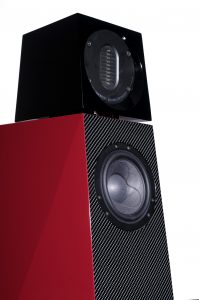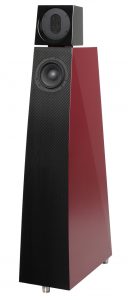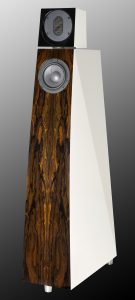Kawero! Vivace – room-friendly with hall-filling scale
 The Kawero! Vivace has some of the best drive units in the world, a crossover screened with material from the Stealth aircraft programme and a ‘quiet’ cabinet of synthetic wood so dense that it is used as a neutron shield in nuclear research and will stop .357 Magnum bullets.
The Kawero! Vivace has some of the best drive units in the world, a crossover screened with material from the Stealth aircraft programme and a ‘quiet’ cabinet of synthetic wood so dense that it is used as a neutron shield in nuclear research and will stop .357 Magnum bullets.
Praise has been heaped on the Vivace’s bigger brother, the Classic, with numerous ‘best sound at the show’ comments. Now this very clever, even deceptive, slim-fronted Vivace floor-stander design is claiming similar comments but for a speaker at a much lower price.
The design concept is to bring the scale, power and transparency of physically big speakers, too dominant for many rooms, in a package no larger than conventional floor-standers. Credit for that achievement goes to the incredibly dense, ‘quiet’ cabinets – beasts to manufacture – that allow the drive units to project their sound energy from a vibration-free platform.
Here is a review by Paul Messenger HIFI+ Kaiser Vivace review. It’s worth reading the four pages of the review more than once because there are several layers to peel back. See also our reaction below*, highlighting how his opinions developed with further listening.
In Issue 83 (November 2011) hifi+ magazine rated the Vivace amongst ‘the best of the best’, alongside favourites such as B7W 802D and Sonos Faber Amati Futura, saying ‘It’s one of those speakers that gets under the listener’s skin and you find yourself unable to listen to anything else.’
The design expertise behind the speakers comes from Rainer Weber of Kaiser Acoustics in Bavaria who is an acoustics consultant to companies like Mercedes Benz and BMW in the automotive industry. He has designed the Vivace and Kawero to produce a hall-filling sound with lifelike instruments and voices, yet from a domestically-friendly, compact cabinet. How is this possible with only a ribbon tweeter and a small cone driver visible on the front?
This clever concept means that the Vivace works with the room, not fighting it and setting up difficult modes.

Slim-line Vivace speaker creates a hall-filling sound
The result is a wide-open, huge soundstage in which the loudspeakers completely disappear. What is left is a truly three-dimensional musical picture that simply hangs in space in the listening room, offering width, depth and height separation for the performers.
Components
Major contributors to the performance are the best ScanSpeak drive units, the Illuminators, the Mundorf Air Motion Transformer tweeter and the Tankwood cabinet material, formed when beechwood is injected with resin and compressed under high temperature and 2,000 atmospheres of pressure to create new chemical bonds. Kaiser have found that not only does Tankwood have excellent damping properties but also is perfect for musicality, natural tone richness and authentic timbral colour. Most other conventional cabinet materials have their own recognisable character.
Our connection with Kaiser and the Vivace speakers comes through our strong association with Vertex AQ, now merged into Quiescent Technologies. Their EMI and RFI absorption technology is applied at the most effective point possible – right in the heart of the crossover – using the materials and design knowledge employed in their HiRez products. The benefit is a huge jump in transparency, separation and fine detail as the crossover components now work in an environment ‘cleaned’ of electrical and mechanical pollution.
See also the practical application of Kaiser acoustic treatments under Room Acoustics on this site.
 The Vivaces can be finished in a wide choice of wood veneers and painted in almost any colour to suit a customer’s décor. Above is an example finished in a Burgundy red while here is one in Lamborghini Orange. Prices will be affected by these choices but start from just over £22,000 per pair and rise to about £30,000 with options including a carbon fibre baffle with a high gloss finish, like the examples here.
The Vivaces can be finished in a wide choice of wood veneers and painted in almost any colour to suit a customer’s décor. Above is an example finished in a Burgundy red while here is one in Lamborghini Orange. Prices will be affected by these choices but start from just over £22,000 per pair and rise to about £30,000 with options including a carbon fibre baffle with a high gloss finish, like the examples here.There is also a smaller stand-mounted loudspeaker in the family, the Chiara, based on the same design principles. Suited to smaller rooms, the Chiara shares the same “big beyond its size” character, with the presence and power of a conventional floor stander Launched at the 2012 Munich High-End show it created a huge response and, in conjunction with the Kaiser room treatments, earned a ‘best sound at the show’ award from The Audio Beat – Audio Beat Munich
* Vivace review in hifi+ magazine
In Issue 82 of hifi+ magazine there is an excellent and comprehensive review of our Kawero! Vivace loudspeaker. Paul Messenger, highly-regarded as one of the most experienced loudspeaker reviewers, has brought to life his listening with the speakers over several weeks.
It’s worth reading the four pages of the review more than once because there are several layers to peel back. Paul does raise questions over some aspects of the performance, particularly at the outset of his session, but it’s clear that he thoroughly enjoyed their music-making and ‘was very sorry when the time came for them to be collected.’
He makes very valid points about the difficulty for the reviewer of assessing a complex, unusual and high-performance product. His questions concern the tonal balance of the speakers, the relationship especially between bass and treble. This Vivace pair contained the optional Vertex crossover and Steve Elford of the company helped Paul with positioning the speakers in his (acknowledged) bass-sensitive room. Steve also made some simple modifications to balance the bass response better to the room. (Read the Vertex reaction to the review:
After these changes and as he lived longer with the speakers he describes the ‘very clean bass delivery‘, ‘with excellent agility, plenty of bass detail, and an exceptionally wide dynamic range‘. The midrange is labelled ‘quite outstanding‘ with examples of new revelations in the performances.
Paul’s experience with the treble region is especially interesting because there are parallels with the reactions of some customers who take time to adjust to a system that does not sound like their own. The Vivace treble is produced by the extraordinary Mundorf Air Motion Transformer that is rather like a 4-litre engine doing 40mph – effortless and with very low distortion. In this way it has massive reserves of headroom and is very smooth, ‘silky smooth‘ in Paul’s words. When there is distortion or resonance in any system component it will tend to accentuate matching frequencies in the music, making them stand out – so minimal distortion equals minimal accenting.
Later Paul concludes ‘this speaker doesn’t sound in the least bit dull, and actually seems very well judged‘.
Overall ‘its magnificent dynamic range, fine timing and superior coherence actually provide rather more information about the recording processes than any other speaker I can readily recall‘ – from one of the most experienced loudspeaker reviewers. Yes.
That is why we added them to our portfolio.



